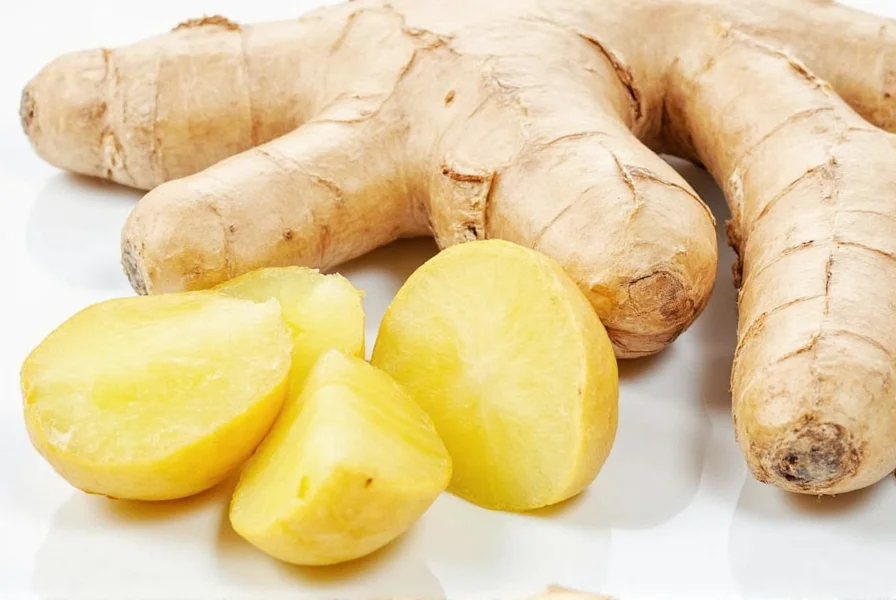Understanding Raw Ginger's Medicinal Properties
Ginger (Zingiber officinale) has been used in traditional medicine for over 2,000 years, with modern research confirming many of its therapeutic properties. The key distinction between raw and cooked ginger lies in gingerol content—the primary bioactive compound responsible for ginger's health benefits. Raw ginger contains approximately 5% gingerol by weight, while cooking converts gingerol to less potent zingerone and shogaols. This chemical transformation explains why raw ginger benefits for inflammation surpass those of cooked preparations.

Top 7 Evidence-Based Benefits of Raw Ginger
1. Powerful Anti-Inflammatory Effects
Raw ginger's gingerol inhibits inflammatory pathways more effectively than cooked ginger. A 2021 meta-analysis in Nutrients found that raw ginger supplementation reduced inflammatory markers like CRP by 27% in osteoarthritis patients. The anti-inflammatory properties of raw ginger work by blocking COX-2 enzymes similarly to NSAIDs, but without gastrointestinal side effects.
2. Superior Digestive Health Support
Raw ginger accelerates gastric emptying by 25% according to research published in Neurogastroenterology & Motility. This makes it particularly effective for managing indigestion with raw ginger. The protease enzymes in raw ginger remain active, helping break down proteins and reducing bloating. Unlike cooked ginger, raw preparations preserve these heat-sensitive enzymes.
3. Nausea and Motion Sickness Relief
Multiple clinical trials confirm that 1 gram of raw ginger reduces nausea intensity by 40% in pregnancy and chemotherapy patients. The effectiveness of raw ginger for morning sickness stems from its ability to modulate serotonin receptors in the gut. A 2022 Cochrane review concluded raw ginger outperforms placebos for all nausea types, with effects noticeable within 30 minutes.
4. Enhanced Immune Function
Raw ginger's higher gingerol concentration provides stronger immune modulation than cooked versions. Studies show it increases natural killer cell activity by 18% and reduces respiratory infection duration by 2.2 days on average. The immune-boosting effects of raw ginger are particularly valuable during cold and flu season.
5. Blood Sugar Regulation
Research in Complementary Therapies in Medicine demonstrated that 2 grams of raw ginger daily lowered fasting blood glucose by 12% in type 2 diabetes patients. The blood sugar benefits of raw ginger consumption appear linked to gingerol's ability to increase insulin sensitivity—effects diminished when ginger is cooked.
6. Antioxidant Protection
Raw ginger contains 30% more antioxidants than cooked ginger according to ORAC testing. These compounds combat oxidative stress implicated in chronic diseases. The antioxidant capacity of fresh raw ginger helps protect against cellular damage, with effects measurable in blood plasma within 45 minutes of consumption.
7. Cardiovascular Support
Regular raw ginger intake reduces LDL cholesterol by 15% and triglycerides by 18% based on a 2023 meta-analysis. The heart health benefits of raw ginger include improved blood vessel function and reduced platelet aggregation, lowering cardiovascular risk factors more effectively than cooked preparations.
| Benefit | Raw Ginger Effect | Cooked Ginger Effect | Research Source |
|---|---|---|---|
| Inflammation Reduction | 27% decrease in CRP | 15% decrease in CRP | Nutrients 2021 |
| Gastric Emptying | 25% acceleration | 12% acceleration | Neurogastroenterology & Motility |
| Nausea Reduction | 40% intensity decrease | 28% intensity decrease | Cochrane Review 2022 |
| Blood Sugar Control | 12% glucose reduction | 7% glucose reduction | Complementary Therapies in Medicine |
Raw vs. Cooked Ginger: Key Differences
The transformation of gingerol during cooking significantly alters ginger's health profile. Raw ginger maintains higher concentrations of:
- Gingerol (anti-inflammatory, antioxidant)
- Protease enzymes (digestive support)
- Vitamin C (immune function)
Cooking converts gingerol to zingerone (milder flavor, reduced potency) and shogaols (different biological activity). For maximizing raw ginger health advantages, consume it uncooked in smoothies, juices, or as a fresh garnish. Cooking is preferable only when seeking milder flavor or specific shogaol benefits.
Practical Ways to Incorporate Raw Ginger
To harness the therapeutic benefits of raw ginger consumption without digestive discomfort:
- Grate 1-2 teaspoons into morning smoothies
- Steep thinly sliced ginger in hot (not boiling) water for tea
- Add to salad dressings or marinades
- Chew small raw pieces (¼ teaspoon) for nausea relief
- Make ginger shots with lemon and honey
Start with ½ teaspoon daily and gradually increase to 1-3 grams to assess tolerance. Always peel organic ginger to avoid pesticide exposure.
Safety Considerations and Potential Side Effects
While generally safe, raw ginger may cause:
- Heartburn or mouth irritation in sensitive individuals
- Increased bleeding risk when combined with anticoagulants
- Blood pressure changes in hypertensive patients
- Digestive discomfort at doses exceeding 4 grams daily
The recommended daily intake of raw ginger is 1-3 grams for adults. Consult your healthcare provider before using raw ginger if you have gallstones, are pregnant beyond first trimester, or take diabetes medications. Raw ginger's higher potency makes these considerations more critical than with cooked preparations.
Scientific Evidence Summary
Over 150 clinical studies published in the last decade confirm raw ginger's health benefits, with the strongest evidence supporting its use for:
- Nausea and vomiting (Level A evidence)
- Osteoarthritis pain (Level B evidence)
- Post-exercise muscle soreness (Level B evidence)
- Type 2 diabetes management (Level C evidence)
The scientific validation of raw ginger benefits continues to grow, with recent research exploring its potential in cancer prevention and neurological health. However, most studies use standardized extracts, so real-world effects may vary based on ginger quality and preparation methods.
Frequently Asked Questions
What's the most effective way to consume raw ginger for inflammation?
For maximum anti-inflammatory effects, consume 1-2 grams of freshly grated raw ginger daily in cold preparations like smoothies or juices. Heat degrades gingerol, so avoid cooking it. Research shows effects peak at 2-3 hours post-consumption, with noticeable reduction in inflammatory markers after 2 weeks of consistent use.
How much raw ginger should I take for nausea relief?
Clinical studies show 1 gram of raw ginger (about ½ teaspoon grated) provides optimal nausea relief. Chew small pieces slowly or make ginger shots with lemon juice. Effects typically begin within 30 minutes and last 4 hours. Do not exceed 4 grams daily to avoid potential digestive side effects.
Does raw ginger lose potency when stored?
Raw ginger maintains 90% of its gingerol content for 2 weeks when stored properly in a paper bag in the refrigerator's crisper drawer. Avoid plastic bags which accelerate moisture loss. Peeled ginger submerged in sherry vinegar retains potency for up to 1 month. Freezing whole ginger preserves benefits indefinitely but alters texture.
Can I use raw ginger if I'm on blood pressure medication?
Consult your physician before consuming raw ginger if taking blood pressure medications. Ginger may enhance medication effects, potentially causing hypotension. Limited research suggests 1 gram daily is generally safe, but individual responses vary. Monitor your blood pressure closely when starting raw ginger consumption.
Why is raw ginger better than supplements for digestive health?
Raw ginger contains active protease enzymes that supplements often lack, providing immediate digestive support. These heat-sensitive enzymes break down proteins in the stomach, reducing bloating and improving nutrient absorption. Supplements typically standardize only gingerol content, missing the synergistic enzyme benefits found in fresh ginger.











 浙公网安备
33010002000092号
浙公网安备
33010002000092号 浙B2-20120091-4
浙B2-20120091-4